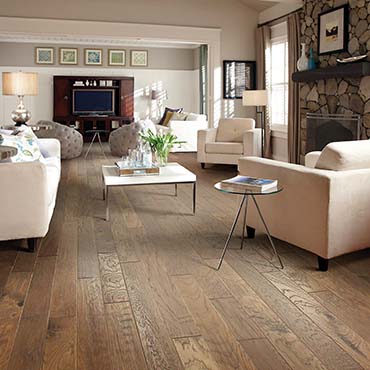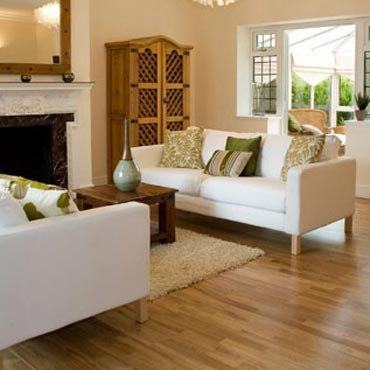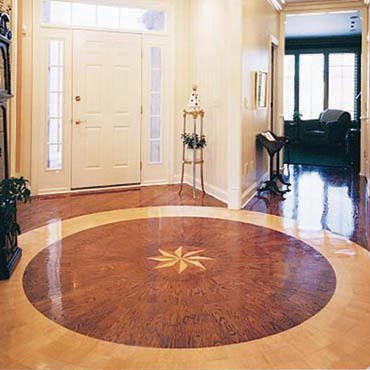Shaw Hardwood Flooring offers consumers the timeless tradition of hardwood flooring with a wide variety of species, colors, and sizes. Shaw hardwood flooring brings Beauty and Strength to Any Room. See our Collection of Wood Flooring Stains and Grains. Learn More
Corners and Inlays
Corners and Inlays Guide

Crafting Elegance Underfoot: The Art of Flooring Corners and Inlays in Contemporary Design
Introduction
In the realm of modern architecture and interior design, the devil is often in the details. Flooring corners and inlays, while seemingly minor elements, play a pivotal role in elevating the aesthetic and functional value of spaces. These details offer a canvas for creativity, allowing architects, designers, and building contractors to infuse uniqueness and sophistication into projects. Beyond mere decoration, they reflect a commitment to sustainability and versatility, harmonizing with various architectural styles and design themes.
Understanding the Basics
- Corners: In wood flooring, corners refer to the precise edges where floorboards meet walls or other surfaces. They can be simple and straight, or intricately designed to add visual interest.
- Inlays: Inlays are decorative elements embedded into the floor surface, often using contrasting wood types or materials. They range from simple geometric patterns to complex, bespoke designs, contributing significantly to a space’s character.
Types of Flooring Corners and Inlays
- Classic Hardwood Corners: These traditional choices, like oak or maple, offer grain patterns and color variations that add warmth and natural beauty. They blend well with both contemporary and classic design themes.
- Exotic Wood Inlays: Woods like teak, mahogany, or bamboo provide unique color tones and durability. Ideal for creating focal points in luxury settings, they resonate with eclectic and opulent themes.
- Geometric Parquetry: This involves arranging pieces of wood in angular, geometric patterns. Perfect for modern and minimalist spaces, they add a structured elegance.
- Custom Artistic Inlays: Tailored to client specifications, these inlays can range from intricate floral patterns to avant-garde abstract designs. They serve as the centerpiece in bespoke luxury interiors.
Each type has its own implications:
- Installation: While hardwood corners are relatively straightforward, custom inlays require skilled craftsmanship and precise planning.
- Durability: Exotic woods and hardwoods offer high durability, while softer woods may be more prone to wear.
- Environmental Suitability: Some woods perform better in humid conditions, while others are more suited to dry climates.
Sustainable Practices
Sustainability in material choice is non-negotiable in today’s design landscape. Eco-friendly wood sourcing, use of reclaimed wood for inlays, and selecting local species to reduce carbon footprint are critical considerations.
Technological Advances
Recent innovations include:
- Improved Finishes: Advanced coatings that extend the life of wood floors and inlays.
- Precision Cutting Techniques: Laser and CNC cutting for immaculate inlay work.
- Installation Technologies: New adhesives and fitting methods that minimize environmental impact and enhance durability.
Conclusion
In conclusion, flooring corners and inlays are not mere details but essential components that define a space's character and functionality. Their choice should be a deliberate part of the design process, reflecting the project's overall aesthetic and practical requirements. With sustainability as a guiding principle and technology as an enabling tool, architects, designers, and contractors can craft spaces that are not only visually stunning but also enduring and responsible. Whether it’s a subtle hardwood corner or an elaborate custom inlay, these elements can dramatically transform any space, making it truly one-of-a-kind.
Disclaimer: The information provided in this article is for general informational purposes only. While we strive to ensure the accuracy and reliability of the information presented, we make no warranties, express or implied, about the completeness, accuracy, reliability, suitability, or availability with respect to the content. Any reliance you place on such information is strictly at your own risk. We recommend consulting with professionals for specific advice tailored to your project’s needs, particularly regarding building codes, regulations, and product specifications.
Under no circumstances shall we be liable for any loss or damage, including without limitation, indirect or consequential loss or damage, arising from the use of, or reliance on, the information provided in this article.
Select Product Sub-Category:
Corners and Inlays
Top 1 Types of Corners and Inlays
 |
Featured Brands
The Best 3 Corners and Inlays Brands

Shaw Hardwood Flooring
Profile | Website | Warranty | Clean | Maintain | GreenShaw Hardwood Flooring offers consumers the timeless tradition of hardwood flooring with a wide variety of species, colors, and sizes. Shaw hardwood flooring brings Beauty and Strength to Any Room. See our Collection of Wood Flooring Stains and Grains. Learn More

Anderson-Tuftex Hardwood
Profile | WebsiteReal wood floors made of Maple, Oak, Beech, Elm, and Pecan should be as familiar to you as the countless city streets that are named after these trees. Their rich natural colors and hand-crafted quality is what we have come to expect in our homes. Now, Anderson has taken wood flooring technology to a place it has never gone before—with Best-in-Class durability. Learn More

Oshkosh Floors
Profile | Website | Brochure | Warranty | BlogHistoric Floors of Oshkosh specializes in unfinished & prefinished medallions and borders plus unfinished parquet floors from multiple species of hardwood. The company stocks medallions and borders shown in their catalog for quick deliveries. Custom projects typically take 3-4 weeks. Oshkosh has a reputation for consistent quality, leadership in design, and prompt deliveries. Learn More
Corners And Inlays News
Latest Corners and Inlays News
Corners/Inlays...The Art of Wood Corners and Inlays in Modern Interior Design In the ever-evolving world of interior design, the devil is indeed in the details. Among these, wood corners and inlays stand out for their ability to infuse spaces with character, warmth, and elegance. This article delves into the significance of these elements in modern interior design, exploring their types, versat... |


